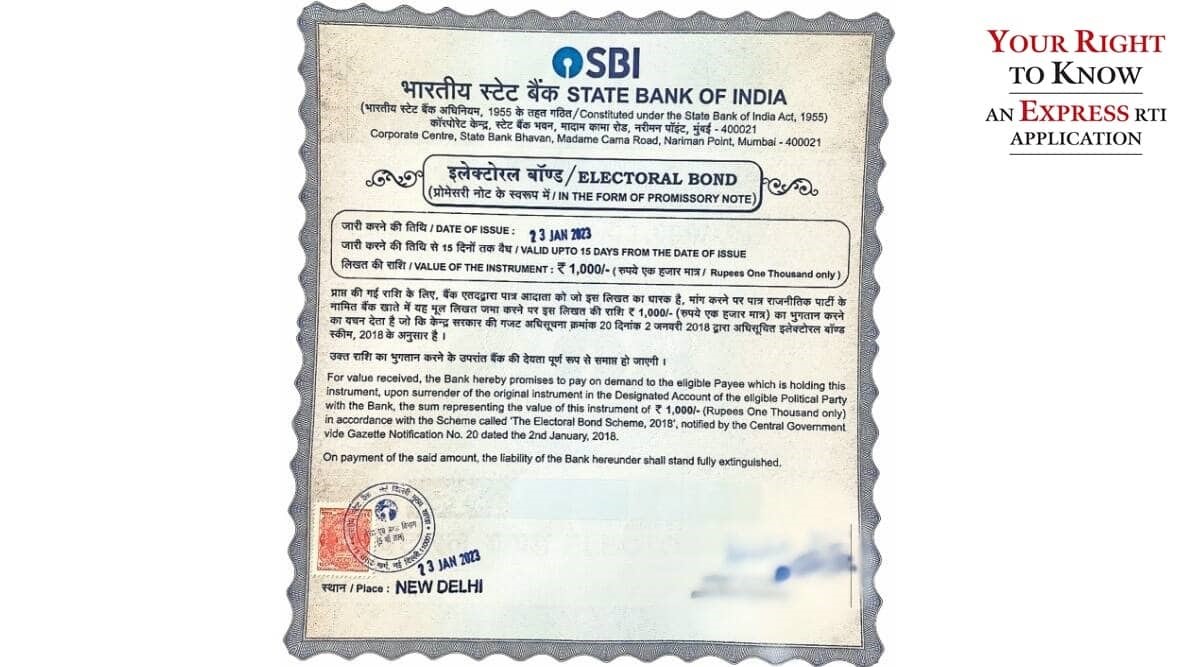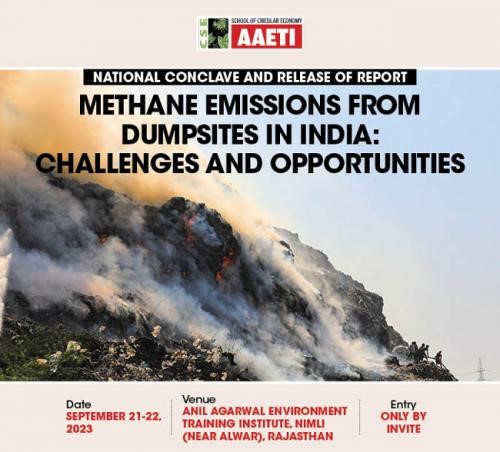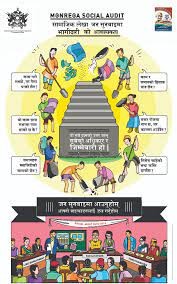- Electoral Bond Sale
- Age of consent under POCSO Act
- NABARD lists first social impact Bond
- Methane emissions from Indian dumpsites
- Sankalp Saptaah
- Social Audit in MGNREGA
- Armageddon Reedtail
Electoral Bond Sale
Context:
The government has recently unveiled the 28th tranche of Electoral Bond sales, which will occur over a ten-day period at authorized branches of the State Bank of India.
Why Discuss Electoral Bonds?
- The announcement of the forthcoming electoral bond sale holds significant implications for the landscape of political funding in India.
- Electoral bonds are a part of the government’s broader efforts to reform the political financing system, aiming to introduce transparency and accountability into campaign financing.
Upcoming Elections:
- The timing of the sales window coincides with the approaching assembly elections in some states, underscoring the pivotal role that electoral bonds play in shaping the financial aspects of political campaigns.
Continued Scrutiny:
- The utilization and impact of electoral bonds continue to be the subject of ongoing debate and examination, with various stakeholders evaluating their role in either enhancing or altering the political funding ecosystem within the nation.
About the Electoral Bond Scheme
Definition: Electoral bonds are banking instruments designed for political party donations while ensuring the anonymity of donors.
Purchase Method: These bonds are accessible to Indian citizens and Indian-incorporated companies through select State Bank of India branches and can be acquired either digitally or by check.
Donation Process:Purchasers have the option to donate these bonds to eligible political parties of their choosing.
Denominations:Electoral bonds are available in multiples of ₹1,000, ₹10,000, ₹10 lakh, and ₹1 crore.
KYC Requirements:Purchasers must adhere to existing KYC norms and make payments from a bank account.
Lifespan of Bonds:To prevent them from being used as a parallel currency, these bonds have a 15-day lifespan.
Identity Disclosure:Donors contributing less than ₹20,000 are not required to provide identity details such as PAN.
Redemption:Electoral Bonds can only be encashed by eligible political parties through an Authorized Bank.
Eligibility of Parties:Only parties meeting specific criteria, including securing at least 1% of votes in the last General Election, are eligible to receive Electoral Bonds.
Restrictions Lifted:Under the Companies Act, foreign and Indian companies can now donate without disclosing their contributions.
Objective:The primary goal of the Electoral Bond Scheme is to enhance transparency in political funding and ensure that the funds collected by political parties are legitimate or “clean money.”
Age of consent under POCSO Act
Context:
In recent developments, the Law Commission has issued a report advocating against any alteration to the age of consent, which currently stands at 18 years under the Protection of Children from Sexual Offences (POCSO) Act.
Law Commission’s Recommendations
- The 22nd Law Commission, led by Ritu Raj Awasthi, has presented Report No. 283 to the Law Ministry concerning a review of the Age of Consent in the POSCO Act.
- The commission suggests introducing “guided judicial discretion” for sentencing in cases involving the implied consent of individuals aged between 16 and 18.
- They also emphasize the necessity for certain amendments to the POCSO Act, 2012, to address situations involving tacit consent.
Understanding Key Terms: Tacit Approval and Guided Judicial Discretion
- Tacit Approval: The term “tacit approval” signifies one person’s agreement or consent to something without explicit verbal confirmation, often due to reluctance to admit such agreement.
- Guided Judicial Discretion: This concept refers to a judge’s authority to make decisions based on their individualized assessment, guided by legal principles. It becomes relevant when the legislature permits such discretion.
Arguments for Retaining the Current Age of Consent
- Arguing for the retention of the current age limit, the commission posits that lowering the age of consent would negatively impact efforts to combat child marriage and child trafficking.
- They also caution courts to exercise prudence, even in cases related to adolescent relationships where criminal intent may be absent.
Reforming the Criminal Procedure Code for e-FIRs
- Additionally, the Law Commission has submitted another report recommending amendments to Section 154 of the Criminal Procedure Code, 1973, to facilitate the phased implementation of e-First Information Reports (e-FIRs), starting with offenses punishable by up to three years of imprisonment.
- The introduction of e-FIRs aims to address delays in FIR registration and enable citizens to report crimes promptly.
The Purpose of the Minimum Age of Sexual Consent
- The minimum age of sexual consent signifies the age at which an individual is deemed capable of providing informed consent for sexual activities.
- Its purpose is to shield adolescents from sexual abuse and the adverse consequences of early sexual engagement on their rights and development.
Need to Review Age of Consent under POSCO
- The need to review the Age of Consent under the POSCO Act has arisen due to a rising number of cases involving adolescent relationships and sexual activity.
- Many High Courts in various states have called for a review because, under the POSCO Act, a “child” is defined as someone under 18 years old, making consent irrelevant, and consensual sexual activity among adolescents equivalent to rape.
The Issue at Hand
- The issue lies in the fact that the enactment of the POCSO Act has led to numerous young couples in consensual and non-exploitative relationships being entangled in the criminal justice system.
- This not only places a significant burden on the courts but also diverts attention from the investigation and prosecution of genuine cases of child sexual abuse and exploitation.
- Therefore, there is a compelling need for legal reform to adjust the age of consent and prevent the criminalization of consensual and non-exploitative acts among older adolescents.
Judicial Interpretations and Acknowledgment
- Recent judicial interpretations have also recognized the normalcy of such relationships and the futility of prosecuting them due to their consensual nature.
- The high rate of acquittals indicates that the law is out of touch with the social realities of adolescent relationships, and blanket criminalization of consensual sexual acts involving older adolescents infringes upon their dignity, best interests, liberty, privacy, evolving autonomy, and developmental potential.
Arguments in Favor of Age of Consent Reform
- Arguments in favor of reforming the Age of Consent highlight the capability of individuals in the 16-18 age group to provide “free consent” in many cases, as these acts are often not against their will and not driven by inducement.
- Moreover, it is observed that contemporary socio-cultural changes have made teenagers more aware of the implications of their actions.
Global Comparison
- Globally, numerous countries, including many American states, European nations, Japan, Canada, Australia, China, and Russia, have set the age of consent at 16 years or below.
Therefore, while the rights of children up to 18 years are protected in line with the UN Convention on the Rights of the Child, reducing the age of consent from 18 to 16 can be considered a reasonable step in line with international practices.
NABARD lists first Social Impact Bond
Context:
In the given context, the National Bank for Agriculture and Rural Development (NABARD) has officially listed its ‘Social Bonds’ on the Bombay Stock Exchange (BSE).
About:
- Regarding this development, NABARD has successfully listed India’s first social impact bond, amounting to 1,000 crore.
- These social bonds, accredited with ‘AAA’ ratings by CRISIL and ICRA, are now available for trading on the Bombay Stock Exchange.
- NABARD has also recently introduced a Sustainability Bond Framework aimed at funding green and social initiatives.
- The funds raised through these bonds will be directed towards supporting Telangana’s Jal Jeevan Mission.
What Are Social Bonds?
- Social bonds are fixed-income securities designed to fund or refinance social impact projects, with a particular focus on target demographics such as low-income individuals, the unemployed, and vulnerable populations.
- Unlike conventional bonds, social impact bonds (SIBs) involve contracts with public sectors or governing authorities, wherein they pay for improved social outcomes in specific areas and share part of the savings with investors.
- It’s important to note that the return on investment for SIBs hinges on the achievement of desired social outcomes.
- The popularity of investing in social impact bonds has grown in recent years, serving as a means for investors to contribute to the community while enabling companies to enhance their social responsibility efforts.
Rationale for Such Bonds:
- Companies are increasingly evaluated based on the Environmental, Social, and Governance (ESG) criteria, which gauge sustainability and ethical impact.
- These criteria encompass environmental factors like greenhouse gas emissions, resource conservation, pollution, deforestation, and climate change; social factors, including working conditions, health, safety, employee relations, and conflict; and governance factors such as tax strategies, charitable donations, political influence, executive compensation, bribery, corruption, and organizational structure.
Key Characteristics of Social Impact Bonds:
- They operate within defined time frames.
- They do not guarantee fixed returns.
- The success of social impact bonds depends entirely on achieving desired social outcomes.
- They are not influenced by variables like reinvestment risk, interest rate fluctuations, or market volatility.
- They are subject to inflation risk.
- Assessing the success of social impact bonds can be challenging since they are centered on social impact measurements.
Bombay Stock Exchange (BSE):
- The Bombay Stock Exchange (BSE), established in 1875, stands as one of Asia’s oldest stock exchanges.
- Notably, BSE is renowned for its benchmark stock market index, the Sensex, which monitors the performance of 30 prominent and well-established companies listed on the exchange.
- BSE offers a diverse array of financial instruments, including equities, mutual funds, bonds, and derivatives, making it a versatile platform for investors.
Furthermore, BSE plays a vital role in overseeing and regulating India’s securities market, ensuring equitable practices and safeguarding investor interests.
METHANE EMISSIONS FROM INDIAN DUMPSITES
Methane Emissions in India: A Breakdown
In 2016, India’s methane emissions (excluding land use, land-use change, and forestry) totaled 409 million tonnes of CO2 equivalent. These emissions were distributed across various sectors:
- Agriculture Sector: Accounting for about 73.96 percent of total methane emissions.
- Waste Sector: Contributing approximately 46 percent of the emissions.
- Energy Sector: Responsible for 62 percent of methane emissions.
- Industrial Processes and Product Use Sector: Conveying a substantial 96 percent of the emissions.
Greenhouse Gas Emissions from the Waste Sector
- The waste sector releases a range of greenhouse gases, including carbon dioxide, methane, and nitrous oxide.
- The primary contributors to methane emissions in this sector are associated with wastewater treatment and discharge, encompassing both industrial and domestic sources.
- Methane production occurs during the decomposition of organic matter in wastewater, whether within treatment plants or after discharge into the environment.
- Factors influencing methane production include wastewater characteristics, treatment methods, and environmental conditions.
- Notably, open dumpsites and landfills are significant anthropogenic sources of methane gas emissions.
The Concerns Surrounding Methane Emissions
- Methane possesses a considerable global warming potential (GWP), with a capacity to trap heat in the atmosphere 25 times greater than that of carbon dioxide (CO2).
- It ranks second only to CO2 in terms of its role in driving climate change during the industrial era.
- The Intergovernmental Panel on Climate Change highlights methane’s global waste production, estimating it to be between 28-36 times that of CO2 when considering its impact over a 100-year timeframe.
- Methane is classified as a short-lived climate pollutant, with a relatively brief atmospheric lifespan of approximately 12 years.
- Moreover, methane can contribute to the formation of ground-level ozone (O3), which is both a hazardous air pollutant and a greenhouse gas. Exposure to ozone is linked to one million premature deaths annually on a global scale.
Exploring Solutions
Waste to Biogas
- An innovative solution involves converting waste into biogas. For instance, 1 tonne per day (TPD) of segregated biodegradable waste generated in Indian cities has the potential to yield 80 to 100 cubic meters of biogas.
- This biogas composition primarily consists of methane (50-75 percent), carbon dioxide (25-50 percent), and smaller amounts of nitrogen (2-8 percent).
- Achieving this involves subjecting waste to a bio-methanation process, either in centralized or decentralized facilities equipped with gas collection systems.
The resulting biogas can serve various beneficial purposes, such as conversion into bio-CNG, electricity generation, or the production of alternative fuels.
Sankalp Saptaah
Inauguration of ‘Sankalp Saptaah’
Recently, the Prime Minister is set to inaugurate ‘Sankalp Saptaah,’ a week-long initiative at Bharat Mandapam, New Delhi.
About ‘Sankalp Saptah’
- Sankalp Saptaah is closely linked to the effective implementation of the Aspirational Blocks Programme (ABP).
- It is designed to facilitate the implementation of the Aspirational Blocks Programme (ABP).
- Chintan shivirs (brainstorming sessions) were conducted at village and block levels across India as a part of ABP preparation. Sankalp Saptah is the culmination of these sessions.
- Sankalp Saptah will be observed in all 500 aspirational blocks.
- Development Themes
- Each day of Sankalp Saptah focuses on a specific development theme.
- The themes for the first six days include “Sampoorna Swasthya,” “Suposhit Parivar,” “Swachhta,” “Krishi,” “Shiksha,” and “Samridhi Diwas.”
Closing Celebration
The last day of the week is dedicated to celebrating the work accomplished during the entire week, known as “Sankalp Saptah – Samavesh Samaroh.”
Participants
The inaugural program includes approximately 3,000 panchayat and block-level people’s representatives and functionaries from across the country at Bharat Mandapam.
About Aspirational Blocks Programme (ABP)
Launch Date
It was launched on January 7, 2023, modeled after the Aspirational District Programme initiated in 2018, covering 112 districts across India.
Objective
The primary aim of ABP is to enhance governance and improve the quality of life in 500 Aspirational Blocks spanning 329 districts across India.
Concentration in States
Over half of these blocks are located in six states: Uttar Pradesh (68 blocks), Bihar (61), Madhya Pradesh (42), Jharkhand (34), Odisha (29), and West Bengal (29).
Approach
It achieves its objectives by converging existing schemes, defining outcomes, and maintaining continuous monitoring, thereby enabling holistic development in areas requiring additional assistance
Social Audit in MGNREGA
Context:
In recent developments, the social audit units associated with the Mahatma Gandhi National Rural Employment Guarantee Act (MGNREGA) Scheme have encountered a series of challenges and issues across various states in India.
Definition of Social Audit:
- Social audit stands as a systematic evaluation process that entails a thorough examination of official records to ensure that reported expenditures correspond accurately to real-world spending on the ground.
- This practice encompasses the evaluation of the social impact of government initiatives, encourages active community involvement, and secures government accountability.
- Notably, it distinguishes itself from financial audits, which primarily concentrate on financial transactions and fiscal stability.
Section 17 of MGNREGA:
- Section 17 of MGNREGA mandates the conduction of social audits for all projects executed under its purview.
- This section empowers the gram sabha (village assembly) to oversee the execution of these projects.
- Each state establishes its independent social audit units to carry out these evaluations.
Characteristics of Social Audit:
- The core focus of a social audit lies in the discovery of facts rather than assigning blame or fault.
- It serves as a means to enhance awareness regarding entitlements and procedural aspects.
- Furthermore, it encourages dialogue among various stakeholders.
- Social audits facilitate prompt resolution of grievances.
- Additionally, they contribute to the strengthening of democratic institutions.
Advantages of Social Audit:
- Social audits play a pivotal role in educating citizens about their rights.
- They provide a platform for expressing needs and addressing grievances.
- These audits actively promote citizen participation in governance.
- They significantly augment transparency and governmental accountability.
- Furthermore, they bolster the framework of decentralized governance.
Challenges Associated with Social Audit Units:
- Malpractice and Recovery: Social audit units often detect malpractices but face challenges when it comes to the recovery of funds and punitive actions, which typically fall under the jurisdiction of state governments, leading to issues related to effectiveness.
- Training and Personnel: Many social audit units encounter deficiencies in training and inadequacy in staff resources.
- Low Recovery Rates: The recovery rates from malpractices have been notably low, which has adversely affected the credibility of the audit process.
- Poor Monitoring: Certain states consistently report “zero cases” and show “zero recoveries,” indicating a deficiency in monitoring practices.
Read this for static portion: https://vikaspedia.in/agriculture/policies-and-schemes/rural-employment-related-1/mgnrega/social-audit-in-mgnregs/social-audit-of-mgnrega







